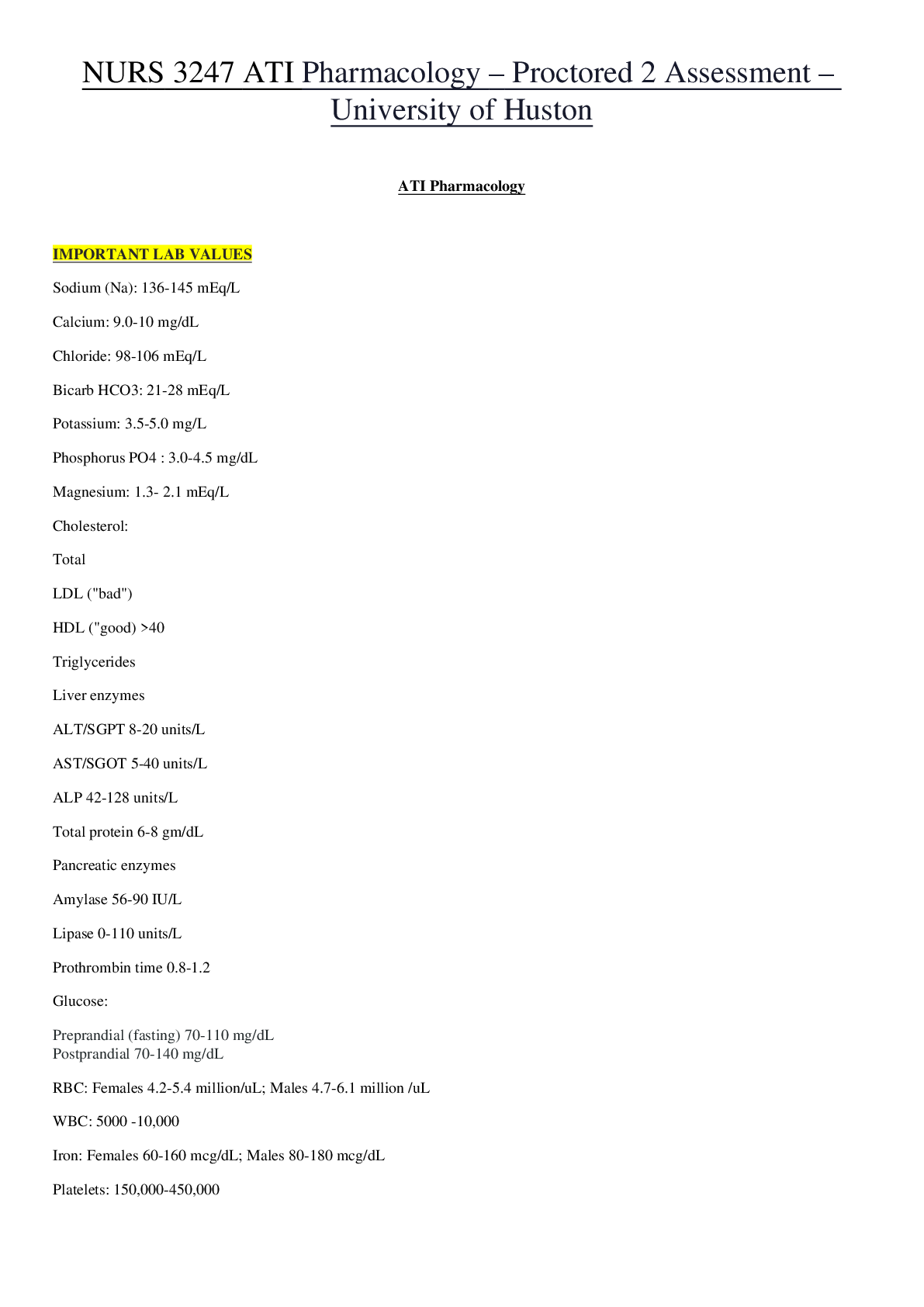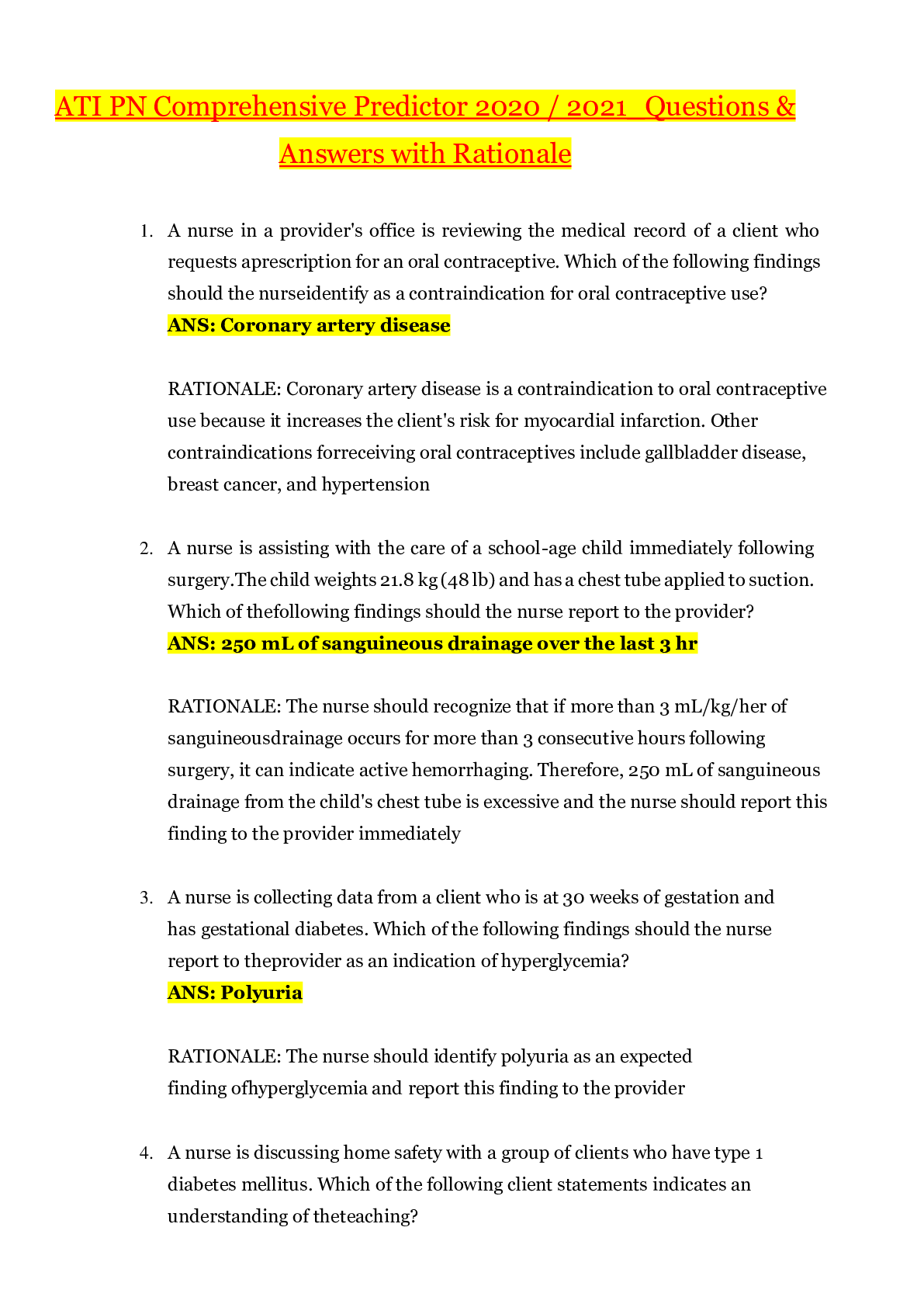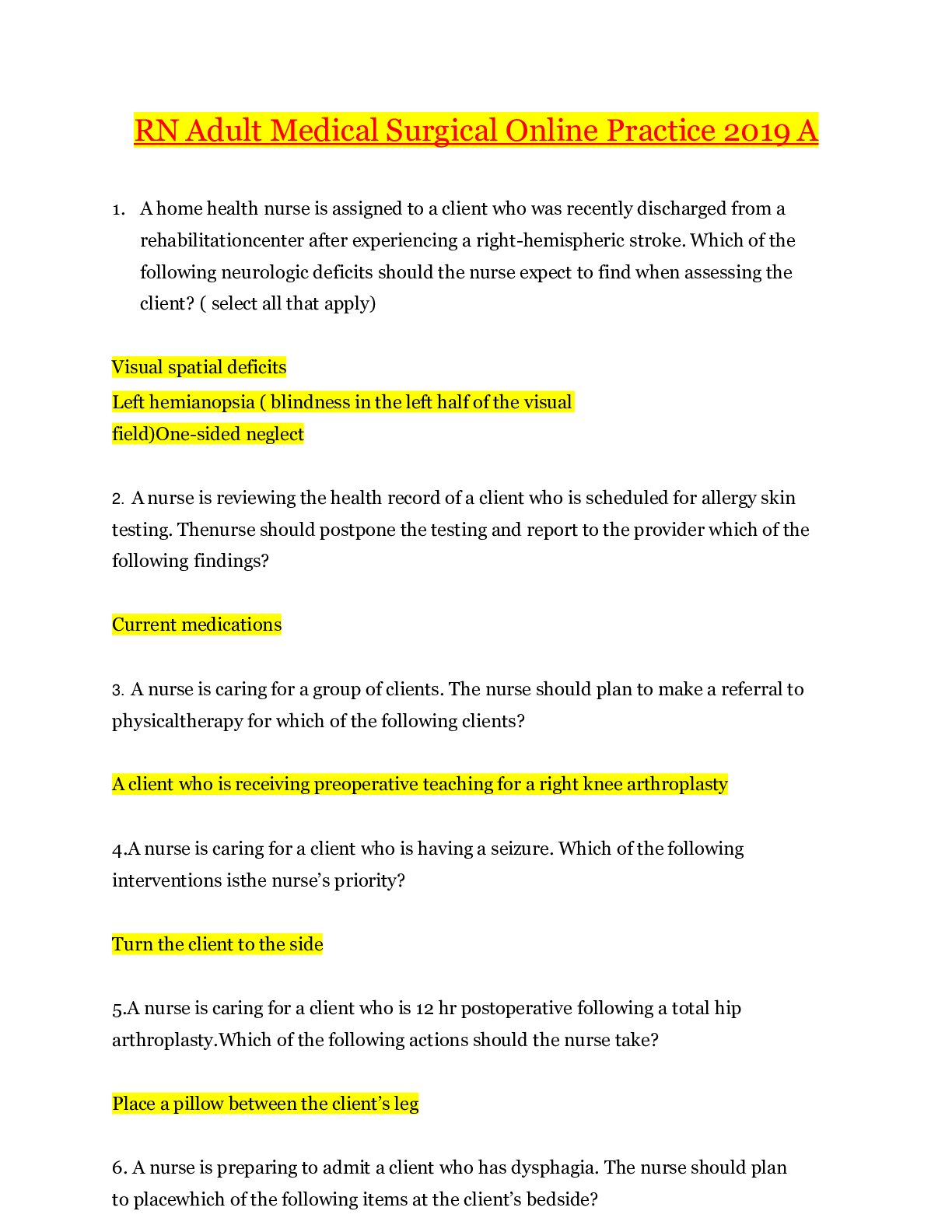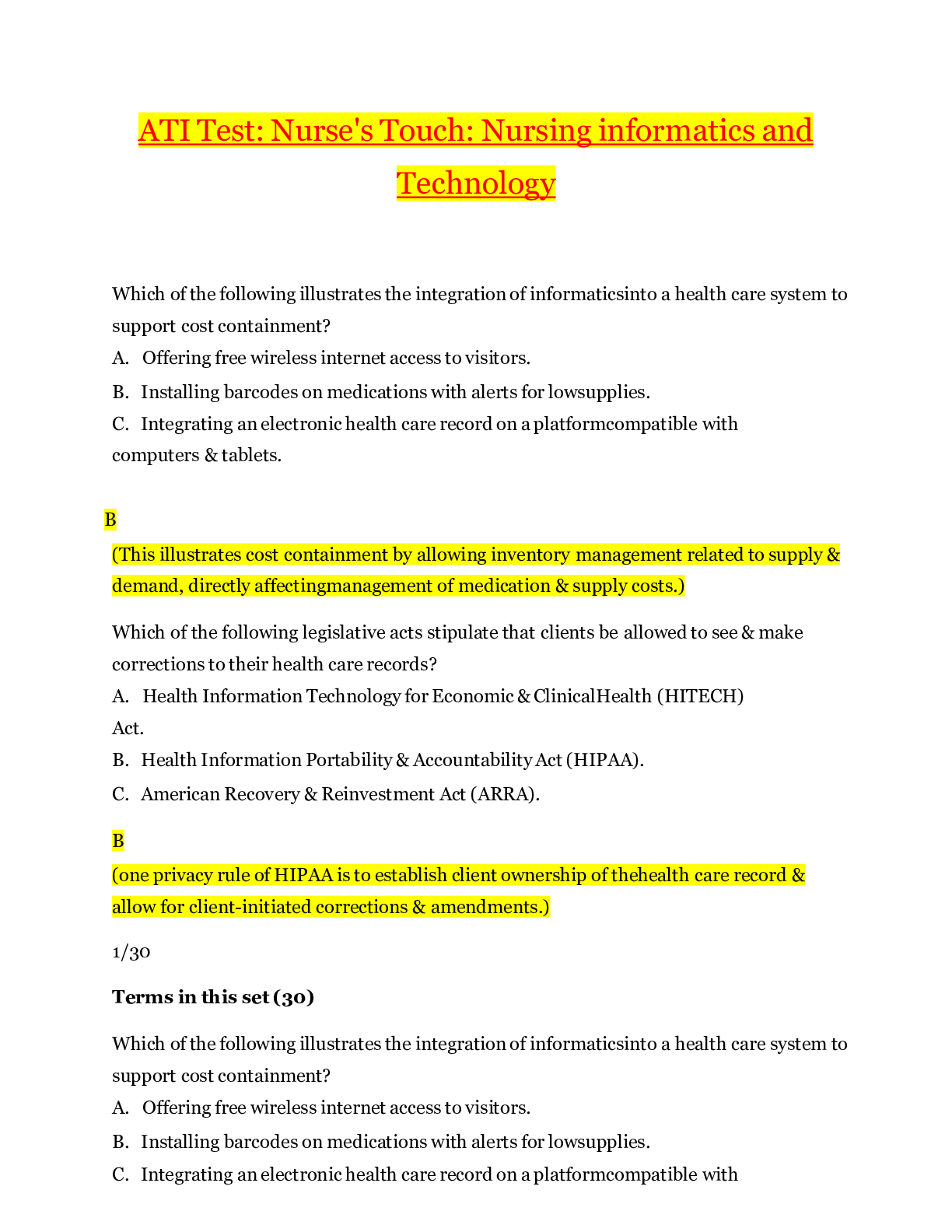Pharmacology > QUESTIONS and ANSWERS > NURS 3247 ATI Pharmacology – Proctored 2 Assessment – University of Huston | NURS3247 ATI Pharma (All)
NURS 3247 ATI Pharmacology – Proctored 2 Assessment – University of Huston | NURS3247 ATI Pharmacology – Proctored 2 Assessment
Document Content and Description Below
NURS 3247 ATI Pharmacology – Proctored 2 Assessment – University of Huston ATI Pharmacology IMPORTANT LAB VALUES • Sodium (Na): 136-145 mEq/L • Calcium: 9.0-10 mg/dL • Chloride: 98... -106 mEq/L • Bicarb HCO3: 21-28 mEq/L • Potassium: 3.5-5.0 mg/L • Phosphorus PO4 : 3.0-4.5 mg/dL • Magnesium: 1.3- 2.1 mEq/L • Cholesterol: o Total <200mg/dL o LDL ("bad") <100 o HDL ("good) >40 o Triglycerides <150mg/dL • Liver enzymes o ALT/SGPT 8-20 units/L o AST/SGOT 5-40 units/L o ALP 42-128 units/L o Total protein 6-8 gm/dL • Pancreatic enzymes o Amylase 56-90 IU/L o Lipase 0-110 units/L o Prothrombin time 0.8-1.2 • Glucose: Preprandial (fasting) 70-110 mg/dL Postprandial 70-140 mg/dL • RBC: Females 4.2-5.4 million/uL; Males 4.7-6.1 million /uL • WBC: 5000 -10,000 • Iron: Females 60-160 mcg/dL; Males 80-180 mcg/dL • Platelets: 150,000-450,000 • Hemoglobin (Hgb): Females 12-16 g/dL; Males 14-18 g/dL • Hematocrit (Hct): Females 37-47%;Males 42-52% • Prothrombin Time (PT): 11-14 seconds: therapeutic range 1.5-2x normal or control value • Urine specific gravity: 1.015-1.030 • Urine pH: average 6.0; range 4.6-8.0 • BUN: 10-20 mg/dL • Creatinine: female 0.5-1.1, males 0.6 - 1.2 mg/dL; • Creatinine phosphokinase MB (CK-MB): normal 30-170 units/L *increase 4-6 hrs after MI and remains elevated 24-72hrs • Troponin normal: <0.2 ng/dL *gold standard for MI - Safe Medication Administration and Error Reduction: Reviewing a Medication Administration Record (RN QSEN - Teamwork and Collaboration, Active Learning Template - Nursing Skill, RM Pharm RN 7.0 Ch. 2) 1) Report all errors, and implement corrective measures immediately 2) Complete an incident report within the time frame the facility specifies, usually 24 hr. 3) Do not reference or include this report in the client's medical record 4) Evaluate clients' responses to medications, and document and report them. 5) Identify side and adverse effects, and document and report them. Chapter 12 - Substance Use Disorders: Therapeutic effect of chlordiazepoxide (Ch. 12 pg.85) - Substance Use Disorders: Smoking cessation using bupropion (Ch. 12 pg. 87) - Substance Use Disorders: Treatment for Cocaine Toxicity (Active Learning Template - System Disorder, RM Pharm RN 7.0 Ch. 12) 1) First line treatment = Benzodiazepines (to reduce CNS & cardiovascular effects) 2) Chlordiazepoxide, diazepam, lorazepam, clorazepate, oxazepam 3) Provide seizure precautions 4) Manifestations include nausea; vomiting; tremors; restlessness and inability to sleep; depressed mood or irritability; increased heart rate, blood pressure, respiratory rate, and temperature; diaphoresis; and tonic‑clonic seizures. Illusions are also common 5) Monitor vitals and neurological status on a regular basis Chapter 13 - Chronic Neurologic Disorders: Adverse effects of neostigmine (Ch. 13 pg. 91) Adverse effects: Excessive muscarinic stimulation Cholinergic crisis - Chronic Neurologic Disorders: Medications that interact with Carbamazepine (Ch. 13 pg. 99) - Carbamazepine causes a decrease in the effects of oral contraceptives and warfarin due to stimulation of hepatic medication-metabolizing enzymes. - Grapefruit juice inhibits metabolism, and thus increases carbamazepine levels. - Phenytoin and phenobarbital decrease effects of carbamazepine. - Chronic Neurologic Disorders: Adverse Effects of Phenytoin (RN QSEN - Safety, Active Learning Template - Medication, RM Pharm RN 7.0 Ch. 13) 1) CNS effects: Nystagmus, sedation, ataxia, double vision, cognitive impairment 2) Gingival hyperplasia: Softening and overgrowth of gum tissue, tenderness, and bleeding gums (consider folic acid supplement) 3) Skin rash (stop medication if rash appears) 4) Cardiovascular effects: dysrhythmias, hypotension (administer slow; 50 mg/min and in dilute solution) 5) Endocrine and other effects: Coarsening of facial features, hirsutism, and interference with vitamin D metabolism (consume enough Vitamin D) 6) Interference with vitamin K‑dependent clotting factors causing bleeding in newborns. - Miscellaneous Central Nervous System Medications: Treating Malignant Hyperthermia (Active Learning Template - Medication, RM Pharm RN 7.0 Ch. 15) - - - - - - - - - - - -- - - - - - - - - - -- - - - - - Interactions: - Penicillin in the same IV solution as aminoglycosides inactivates the aminoglycoside. Do not mix penicillin and aminoglycosides in the same IV solution. - Probenecid (treats Gout) delays the excretion of penicillin. Providers sometimes add probenecid to prolong the action of penicillin therapy. Nursing Administration: - Instruct clients to take penicillin V, amoxicillin, and amoxicillin‑clavulanate with meals. Tell them to take all others with 8 oz. of water 1 hr. before or 2 hr. after meals. - Instruct clients to report any signs of an allergic response such as dyspnea, a skin rash, itching, and hives. - Give IM injections cautiously to avoid injecting into a nerve or an artery. - Advise clients to complete the entire course of therapy, even if symptoms resolve. - Advise client to use an additional contraceptive method when taking penicillins. Cephalosporins: PROTOTYPE: Cephalexin, first generation First generation: Cefazolin (IM/IV) Second generation: Cefaclor, cefotetan (PO) Third generation: Ceftriaxone, cefotaxime (IM/IV) Fourth generation: Cefepime (IM/IV) Adverse effects: - Allergy, hypersensitivity, anaphylaxis, possible cross‑sensitivity to penicillin. - If indications of allergy appear (urticaria, rash, hypotension, dyspnea), stop the cephalosporin immediately, and notify the provider. - Question clients carefully about a history of allergy to a penicillin or another cephalosporin, and notify the provider if present. - Bleeding tendencies from cefotetan and ceftriaxone - Avoid use for clients who have bleeding disorders and for clients taking anticoagulants. - Observe clients for bleeding. - Monitor prothrombin and bleeding times. Delays in clotting can require discontinuation of the - medication. - Administer parenteral vitamin K. - Thrombophlebitis with IV infusion - Rotate injection sites. - Administer as a dilute intermittent infusion or slowly over 3 to 5 min and in a dilute solution for bolus dosing. - Renal Insufficiency - Giver lower dosage of most cephalosporin to prevent accumulation to toxic levels. - Pain with IM injection - Administer IM injections deep into a large muscle mass such as into the ventrogluteal site. - Antibiotic‑associated pseudomembranous colitis - Observe for diarrhea, and notify the provider if present. - Stop the medication. Contraindications/Precautions: - Do not give cephalosporins to clients who have a history of severe allergic reactions to penicillins. - Use cautiously with clients who have renal impairment or bleeding tendencies. Interactions: - Disulfiram reaction (intolerance to alcohol) occurs with simultaneous use of alcohol and either cefotetan or cefazolin. Instruct clients not to consume alcohol while taking these cephalosporins. - Probenecid (gout) delays renal excretion. Monitor I&O. Nursing Administration: - Instruct clients to complete the entire course of therapy, even if symptoms resolve. - Advise clients to take oral cephalosporins with food. - Instruct clients to store oral cephalosporin suspensions in a refrigerator. Carbapenems: PROTOTYPE: Imipenenem-cilastaton (IM/IV), Meropenem (IV) Adverse Effects: - Allergy, hypersensitivity, possible cross‑sensitivity to penicillin or cephalosporins - Monitor for indications of allergic reactions, such as dyspnea, rashes, and pruritus. - Question clients carefully about their history of allergy to a penicillin or other cephalosporin, and notify the provider if present. - Gastrointestinal upset (nausea, vomiting, diarrhea) - Observe for manifestations, and notify the provider if they occur. - Monitor I&O. - Suprainfection - Monitor for indications of colitis (diarrhea), oral thrush, and vaginal yeast infection. Contraindications/ Precautions: - Imipenem‑cilastatin is a Pregnancy Risk Category C medication. - Use cautiously in clients who have renal impairment. Interactions: - Imipenem‑cilastatin can reduce blood levels of valproic acid. Breakthrough seizures are possible. - Avoid using together. If concurrent use is unavoidable, monitor for increased seizure activity. Nursing Administration: - Advise client to complete the entire course of therapy, even if symptoms resolve. Other inhibitors of cell wall synthesis: - Vancomycin (PO/IV) - Aztreonam, a monobactam, (IM/IV) - Fosfomycin (PO) Adverse Effects: Ototoxicity (rare and reversible) - Assess for indications of hearing loss. - Instruct clients to notify the provider if changes in hearing acuity develop. - Monitor vancomycin levels. Infusion reactions - Monitor for red man syndrome: rashes, flushing, tachycardia, and hypotension.) - Administer vancomycin slowly over 60 min. IM and IV injection‑site pain, thrombophlebitis - Rotate injection sites. - Monitor the infusion site for redness, swelling, and inflammation. Renal toxicity - Monitor I&O and kidney function tests. - Monitor vancomycin trough levels. Contraindications/ Precautions: - An allergy to corn or corn products and previous allergy to vancomycin are contraindications. - Use cautiously for older adults and with clients who have renal impairment or hearing loss. Interactions: - Increased risk for ototoxicity when taking vancomycin concurrently with another medication that causes ototoxicity (loop diuretics, aminoglycoside antibiotics). - Assess for hearing loss. Nursing Administration: - Monitor vancomycin trough levels routinely after blood levels have reached a steady state. - For clients who have renal insufficiency, creatinine clearance levels indicate IV dosage adjustments. Nursing Evaluation of Medication Effectiveness: Indications of effectiveness include the following. - Reduction of manifestations such as fever, pain, inflammation, and adventitious breath sounds - Resolution of infection. - Antibiotics Affecting Protein Synthesis: Dietary Supplement Interactions with Tetracycline (Active Learning Template - Medication, RM Pharm RN 7.0 Ch. 45) 1) Instruct clients to take tetracyclines (except for minocycline) on an empty stomach with 8 oz. water. It may be taken with food if gastric distress occurs. 2) Interaction with milk products, calcium and iron supplements, laxatives containing magnesium, and antacids causes formation of nonabsorbable chelates, thus reducing the absorption of tetracyclines. 3) Tell clients not to take tetracyclines just before lying down because it increases the risk of esophageal ulceration. 4) Instruct clients to maintain a 2‑hr interval between ingestion of chelating agents and tetracyclines. 5) Avoid milk products and antacids, or separate by 2 hr. - Urinary Tract Infections: Evaluating Client Response to an Analgesic (Active Learning Template - Medication, RM Pharm RN 7.0 Ch. 46) 1) Urinary tract analgesic (Phenazopyridine) 2) The medication is an azo dye that functions as a local anesthetic on the mucosa of the urinary tract 3) Relieves manifestations of burning with urination, pain, frequency, and urgency 4) Acute kidney injury and chronic kidney disease are contraindications 5) It changes urine to an orange‑red color (can stain clothing) 6) Instruct clients to take it with or after meals to minimize GI discomfort. [Show More]
Last updated: 2 years ago
Preview 1 out of 18 pages

Buy this document to get the full access instantly
Instant Download Access after purchase
Buy NowInstant download
We Accept:

Reviews( 0 )
$12.00
Can't find what you want? Try our AI powered Search
Document information
Connected school, study & course
About the document
Uploaded On
Jan 16, 2021
Number of pages
18
Written in
Additional information
This document has been written for:
Uploaded
Jan 16, 2021
Downloads
0
Views
68





 – Concorde career College.png)








